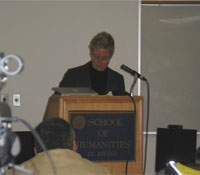UCI Conference Examines Effects of Industrial-Military Complex
03.15.05 – In the 1970s, goats, horses and livestock began turning up dead in largely uninhabited desert areas of New Mexico, Utah and Nevada. These animal deaths were occurring at the same time that the Pentagon was attempting to develop an “invisible” bomber that could skirt enemy radar systems. The top-secret military program, which came to be known as Stealth, was underway in the same areas of the American West where animals were dying, areas that were known as Black Worlds.
|
According to Trevor Paglen, a writer, artist and graduate student in geography at UC Berkeley, these incidents were not unrelated. In a presentation titled “Goatsucker” at UC Irvine’s International Conference on Defense: Models, Strategies, Media, Paglen espoused the theory to approximately 50 participants that chemicals used by Lockheed Martin in the top-secret Stealth program were responsible not only for animal deaths, but for human illness and death as well. The military, however, never accepted any responsibility, even going so far as to deny the existence of the program.
The defense conference, which took place March 7-9, was sponsored by the UCI Department of Film and Media Studies and was underwritten in part by Calit2. It featured 16 provocative sessions, presented by professors, authors and artists from universities in the United States and Europe, and encompassed a wide range of topics relevant to defensive modeling and critical thinking on defensive modes.
Albert Yee, Calit2 Irvine division director, says he was pleased to be able to support the conference. “It provided a unique opportunity for Calit2 to engage in a multi-disciplinary exchange of ideas, especially as the topic relates to the digital culture, visualization and our networked society.”
Jennifer Terry, UCI associate professor of women’s studies, presented a comparative analysis of two entertainment forms used to boost soldiers’ morale during wartime. By comparing USO shows and computer-based battle simulation games, Terry discussed the ways in which both were/are used to increase psychological fitness, battlefield might and patriotic sentiments of enlisted men and women. She also discussed “techno-science,” the blending of gaming and war, in which there is a relationship between entertainment and violence.
Jens Schroeter, a postdoctoral fellow in media revolutions at Germany ’s Siegen University , spoke about the development and distribution of trans-flat “space images” containing more spatial information than conventional images. Schroeter related the history and esthetics of volumetric display and its origins in the retrieval of spatial information for military defense.
Other presentations included: “Freedom Flies: Throwing Money at the Problem of Military Solutions,” presented by Chris Csikszentmihalyi, assistant professor of media arts and sciences at MIT and “Defensive Terror and Model Threats: Virtual/Actual/Banal,” presented by James Der Derian, professor of international studies at Brown University .
International presenters included Etienne Balibar, UCI professor of Italian and French and emeritus professor of philosophy at Universite de Paris-X Nanterre; Eva Horn, associate professor of German at University of Basel, Switzerland; Chris Pias, professor of communication theory and electronic media at University of Essen, Germany; and others.
A complete Web cast of the conference is available at http://www.arts.uci.edu/conference.php.

